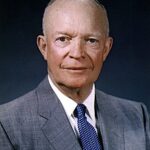The New Look Defense Strategy
President Eisenhower launched his ‘New Look’ defense policy in 1953. This strategy emphasized nuclear weapons over conventional forces. The Eisenhower military industrial complex began expanding rapidly during this period. 📊 Defense spending shifted toward high-tech weapons systems and nuclear arsenals.
The policy aimed to provide ‘more bang for the buck’ through nuclear deterrence. Defense contractors received massive government contracts for missile development. Companies like Lockheed, Boeing, and General Dynamics grew exponentially during this era.
Massive Retaliation Doctrine
Eisenhower’s doctrine threatened nuclear response to any Soviet aggression. This approach required continuous weapons modernization and expansion. ⚠️ The policy accelerated the nuclear arms race with the Soviet Union.
Defense budgets remained high despite promises of fiscal conservatism. Military spending consumed nearly 10% of GDP throughout Eisenhower’s presidency. The president found himself trapped by the system his policies created.
Warning Against His Own Creation
Eisenhower’s 1961 farewell address warned against the military-industrial complex. He criticized the ‘unwarranted influence’ of defense contractors and military leaders. 💰 The irony was clear – he warned against what his policies had accelerated.
Impact:
Nuclear Arms Race Acceleration
The Eisenhower military industrial complex policy dramatically intensified the Cold War arms race. 🔥 Both superpowers built massive nuclear arsenals during the 1950s. The U.S. nuclear stockpile grew from 1,000 to 20,000 warheads under Eisenhower.
Defense contractors became permanent fixtures in American politics and economy. Military spending created jobs in key congressional districts nationwide. Politicians found it difficult to cut defense budgets without facing electoral consequences.
Economic Transformation
Defense spending fundamentally altered the American economy during this period. 📈 Entire regions became dependent on military contracts and defense jobs. California, Texas, and Virginia emerged as major defense industry centers.
Research and development spending skyrocketed to support weapons innovation. Universities received substantial federal funding for defense-related research projects. The partnership between government, military, and industry became institutionalized permanently.
Long-term Political Consequences
Eisenhower’s policies created lasting structural changes in American governance. 🌍 The defense establishment gained unprecedented political influence over foreign policy decisions. Future presidents struggled to control military spending and weapons procurement.
The military-industrial complex became a self-perpetuating system requiring constant expansion. Each new weapons system created constituencies defending continued funding and development.
